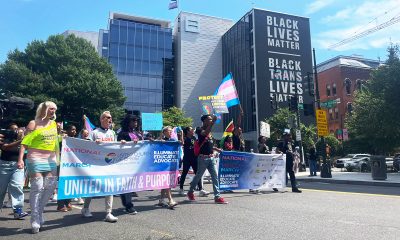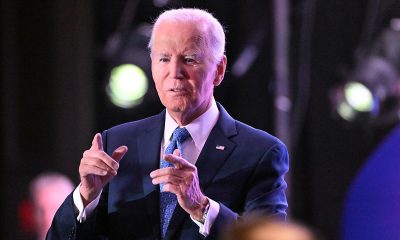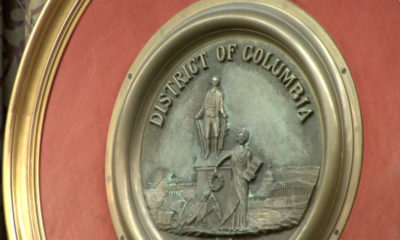National
Prop 8 case wraps up, ruling expected in weeks
Appeals could take years; may be destined for Supreme Court
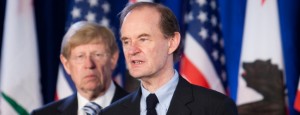
Attorneys Ted Olson and David Boies (front) are waging the case against Proposition 8, which banned same-sex marriage in California. (Photo courtesy of Equal Rights Foundation)
Marriage equality supporters were focused this week on the closing arguments in a case that could end California’s ban on same-sex marriage and similar bans throughout the country.
In the case Perry v. Schwarzenegger, attorney Ted Olson, a former U.S. solicitor general for former President George W. Bush, was set to give his final arguments in favor of same-sex marriage on Wednesday, after Blade deadline.
The legal challenge, pending before Chief Judge Vaughn Walker of the U.S. District Court of Northern California, aims to invalidate Proposition 8, a ballot initiative in 2008 that ended same-sex marriage in the Golden State.
In a conference call last week with reporters, Olson made the case for same-sex marriage in California. He noted that the U.S. Supreme Court has “declared again and again” that being able to choose the person one wants to marry “is a fundamental right in this country.”
“It is vital to the opportunity for people to be a part of communities, of neighborhoods — to be able to join together in a committed relationship and to bond with one another in a relationship sanctioned by the state,” he said.
Olson compared Prop 8 to state laws banning interracial marriage, which the U.S. Supreme Court struck down in the 1967 case Loving v. Virginia, and said he was presenting the same arguments in the Perry case.
“The parents of our president of the United States would have committed a crime had they been married at the time our president was born,” Olson said.
Olson said Prop 8 is unconstitutional in part because the referendum created four separate classes of people in California with respect to marriage.
They are same-sex couples who married in California before Prop 8 passed and remain married; same-sex couples who cannot marry; same-sex couples who married in other jurisdictions and have full legal marriage rights in California; and opposite-sex couples whom Olson said can marry whomever those choose “even if they’re in prison, even if they’re child abusers, or even if they’re 90 years old.”
Olson litigated the case in partnership with David Boies, an attorney who’s also been involved in high-profile cases. The two men were on opposite sides of Bush v. Gore in 2000; Olson represented then-Republican presidential candidate Bush while Boies represented Democratic presidential candidate Al Gore.
Boies, who cross-examined defendant witnesses during the trial, said, “there isn’t any support” for the arguments advanced by proponents of Prop 8 during the trial.
Proponents of Prop 8, Boies said, presented several arguments that failed under examination, such as the purpose of marriage being procreation, that marriage has always been between one man and one woman, and that same-sex marriages could endanger opposite-sex marriages.
“None of the defendant witnesses supported those propositions, and, in fact, all of their witnesses who spoke on those issued ended up giving contrary testimony,” Boies said.
For example, he said, witnesses under examination acknowledged that procreation has never been a requirement for marriage and many societies in the past have allowed same-sex marriage, including for a time California after the state’s Supreme Court in 2008 ruled that same-sex nuptials were mandated under the state constitution.
“It was only the passage of Proposition 8 that took this right away from gay and lesbian couples even in California,” Boies said.
Additionally, Boies said defendants’ witnesses acknowledged on the stand that prohibiting LGBT couples from marrying “caused them serious damage, and caused the hundreds of thousands of children that those couples were raising serious damage.”
Boies also said defendants were unable to produce witnesses that could provide “a shred of evidence” that same-sex marriage endangers opposite-sex marriage.
“It’s a critically important case, but it’s one in which the facts really are not in dispute,” Boies said. “The other side doesn’t have a legal argument, they don’t have a factual argument — they got a circular bumper sticker for a case.”
Proponents of Prop 8 will also have an opportunity to offer remarks during closing arguments. Chuck Cooper, lead attorney for defendants, will represent those arguing for the court to uphold Prop 8.
In a statement, Jim Campbell, an attorney for Alliance Defense Fund, a conservative legal firm working on the case, said defendants would emphasize arguments they made throughout the trial.
“The team of attorneys defending Proposition 8 will highlight all the reasons why Proposition 8 is constitutional,” he said. “In doing so, they will emphasize the reasons why Proposition 8 is not only rational, but also why preserving marriage as one man and one woman is good social policy.”
Jennifer Pizer, marriage project director and senior counsel for Lambda Legal, predicated both sides in the Perry case would “survey the evidence” already presented during the trial.
She said Olson and Boies presented “a massive evidentiary record” before the court and expected them “to offer a structure for this mountain of relevant evidence that they have submitted.”
For proponents of Prop 8, Pizer said she expects attorneys to “make a mountain out of the barely noticeable molehill of evidence” that they’ve submitted.
She said much of the defendants’ evidence was submitted from individuals who weren’t qualified as experts, meaning they weren’t in court and qualified according to the rules and therefore not examined.
“The defendants offered into evidence a pile of articles without explanation of who the authors were or why any of their writings might be relevant to anything,” she said. “So I suspect that Chuck Cooper may refer to many of those documents as if they were relevant evidence, but they’re not.”
Pizer also predicted that the defendants would argue that the “anti-gay prejudice that infused and inspired the Prop 8 campaign” isn’t legally relevant to whether the initiative is constitutional. Still, Pizer said she believes this anti-gay bias was the sole purpose of Prop 8.
“The proponents of Prop 8 were inspired by anti-gay prejudice and they sent the voting public misinformation in a deliberate attempt to confuse and induce people to vote their prejudice into law — and they succeeded,” she said.
Pizer said Lambda was involved in the Perry case by filing two friend-of-the-court briefs in favor of the legal challenge to Prop 8 as well as providing resource assistance to plaintiffs in the case.
Earlier this month, Walker presented an 11-page list of questions he wanted attorneys on both sides of the case to answer during closing arguments. Among the topics for plaintiffs was a requested review of any empirical data showing that the availability of same-sex marriage reduces discrimination against LGBT people.
During the conference call, Olson said that such data can be found in the ballot label for Prop 8, which noted the measure “eliminates the rights for same-sex couples to marry.”
“You are not only stating that the state creates discrimination, but that the state sanctions discrimination — and sanctions the points of the attitudes — that bring about private discrimination,” Olson said. “It has always been the case that when the court eliminates state discrimination … that people open up and realize that what they’re doing themselves is not permissible.”
Another question was how the court could find Prop 8 unconstitutional without also invalidating the Defense of Marriage Act, the 1996 law prohibiting federal recognition of same-sex marriages.
Boies said the matter under consideration is different from DOMA because state law traditionally determines marriage in the United States, although some of the constitutional arguments against DOMA are similar to those against Prop 8.
“For all of the rights that are a matter of state law — which are the majority of rights that are involved — it is critical that people have the right to marry even if DOMA were to continue to exist,” Boies said.
Several observers following the case have predicted that Walker will rule in favor of plaintiffs, although how subsequent courts will rule on any appeal remains to be seen.
Pizer said she couldn’t predict how Walker will rule in the case, but noted that the questions he’s posed show a focus on “questions of causation.”
“He is focused on whether there are adequate government purposes and whether there’s a proper causal relationship between what Prop 8 actually does and goals that the state is actually permitted to have,” she said. “Advancing prejudice is never a proper government purpose.”
In response to a Blade inquiry on the timeline for the case, Olson said he expects a decision from Walker in the case within weeks of the closing arguments. The next step would be taking the case to the U.S. Court of Appeals for the Ninth Circuit.
Olson said he hopes that Walker will find Prop 8 unconstitutional and allow LGBT people to start marrying in California immediately, but noted that if he withholds institution of that decision, plaintiffs hope the Ninth Circuit would hear the case “in a hurry.”
“That’s probably a process that would take perhaps a year, although we moved through this case fairly rapidly so far,” Olson said.
The case could then be appealed to the U.S. Supreme Court. Olson said following the appeals court ruling, it would take six to eight months to get the case on the docket for the high court.
But Pizer said it’s difficult to determine how long the case would remain in the Ninth Circuit because it could first go before a three-judge panel — and then advance to an 11-judge panel.
“That’s a long way of saying it’s impossible to tell how long it would be between now and the Supreme Court,” she said. “It might be two years or three years. Anybody who gives you a prediction is making a guess.”
Asked whether the Supreme Court would examine only the constitutionality of Prop 8 or the validity of same-sex marriage bans throughout the country, Olson said the scope of the examination would be up to the Supreme Court.
“It will also be a part and a function of what the district court and the Ninth Circuit of Appeals decides, and who’s the party bringing the case to the Supreme Court, but I think that the court will have a menu of opportunities,” he said.
Olson said it’s possible the Supreme Court would only examine the constitutionality of the same-sex marriage ban in California because Prop 8 is “particularly egregious.”
He noted that California was the only state to allow same-sex couples to marry and then eliminate that right — and the only state to create four sets of classes of couples.
Still, Olson said “at the base” of the Perry case is the fundamental right to marry, which would apply to same-sex marriage bans throughout the country.
“I think there will be a great temptation once it gets to the Supreme Court for the justices to say, ‘This case can come back to us in various forms; we should look at the fundamental rights and decide the rights of these Americans now once and for all,’” Olson said. “We hope that that would be the case.”
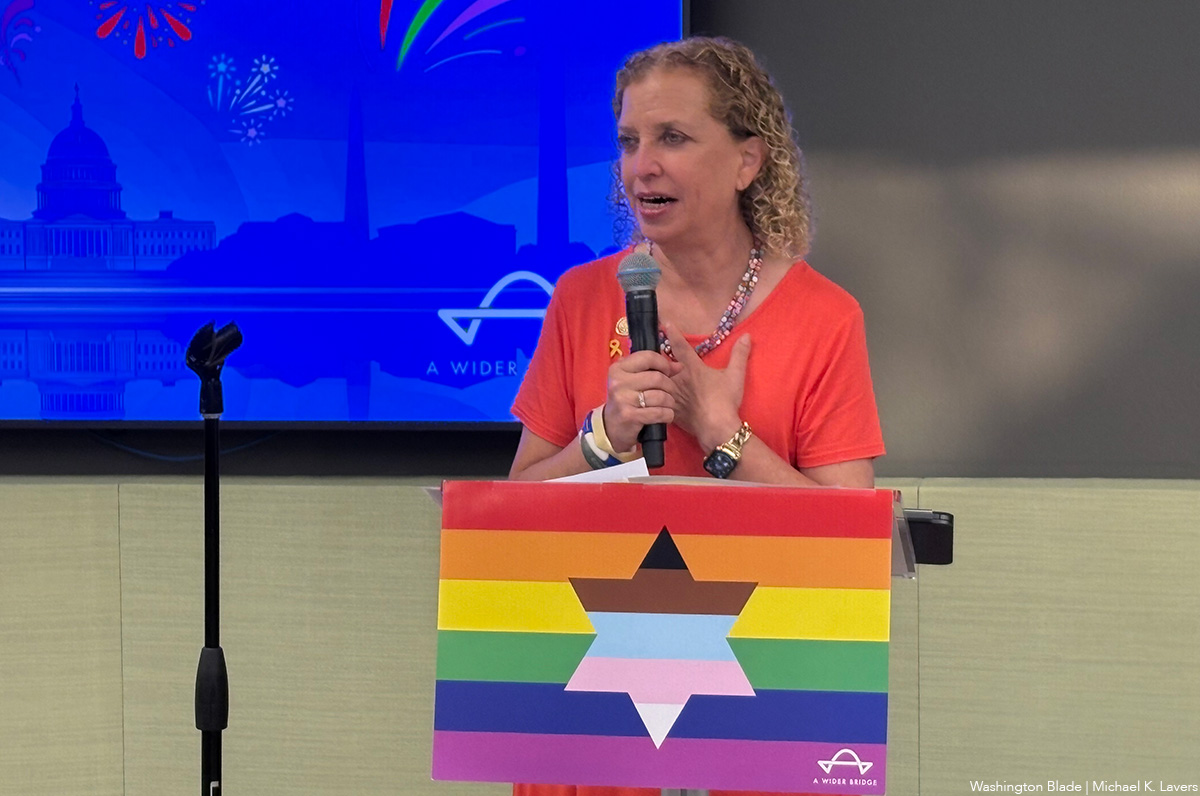
A Wider Bridge on Friday announced it will shut down at the end of the month.
The group that “mobilizes the LGBTQ community to fight antisemitism and support Israel and its LGBTQ community” in a letter to supporters said financial challenges prompted the decision.
“After 15 years of building bridges between LGBTQ communities in North America and Israel, A Wider Bridge has made the difficult decision to wind down operations as of Dec. 31, 2025,” it reads.
“This decision comes after challenging financial realities despite our best efforts to secure sustainable funding. We deeply appreciate our supporters and partners who made this work possible.”
Arthur Slepian founded A Wider Bridge in 2010.
The organization in 2016 organized a reception at the National LGBTQ Task Force’s Creating Change Conference in Chicago that was to have featured to Israeli activists. More than 200 people who protested against A Wider Bridge forced the event’s cancellation.
A Wider Bridge in 2024 urged the Capital Pride Alliance and other Pride organizers to ensure Jewish people can safely participate in their events in response to an increase in antisemitic attacks after Hamas militants attacked Israel on Oct. 7, 2023.
The Jewish Telegraphic Agency reported authorities in Vermont late last year charged Ethan Felson, who was A Wider Bridge’s then-executive director, with lewd and lascivious conduct after alleged sexual misconduct against a museum employee. Rabbi Denise Eger succeeded Felson as A Wider Bridge’s interim executive director.
A Wider Bridge in June honored U.S. Rep. Debbie Wasserman Schultz (D-Fla.) at its Pride event that took place at the Capital Jewish Museum in D.C. The event took place 15 days after a gunman killed two Israeli Embassy employees — Yaron Lischinsky and Sarah Milgrim — as they were leaving an event at the museum.
“Though we are winding down, this is not a time to back down. We recognize the deep importance of our mission and work amid attacks on Jewish people and LGBTQ people – and LGBTQ Jews at the intersection,” said A Wider Bridge in its letter. “Our board members remain committed to showing up in their individual capacities to represent queer Jews across diverse spaces — and we know our partners and supporters will continue to do the same.”
Editor’s note: Washington Blade International News Editor Michael K. Lavers traveled to Israel and Palestine with A Wider Bridge in 2016.
The White House
‘Trump Rx’ plan includes sharp cuts to HIV drug prices
President made announcement on Friday

President Donald Trump met with leaders from some of the world’s largest pharmaceutical companies at the White House on Friday to announce his new “Trump Rx” plan and outline efforts to reduce medication costs for Americans.
During the roughly 47-minute meeting in the Roosevelt Room, Trump detailed his administration’s efforts to cut prescription drug prices and make medications more affordable for U.S. patients.
“Starting next year, American drug prices will come down fast, furious, and will soon be among the lowest in the developed world,” Trump said during the meeting. “For decades, Americans have been forced to pay the highest prices in the world for prescription drugs by far … We will get the lowest price of anyone in the world.”
Trump signed an executive order in May directing his administration “to do everything in its power to slash prescription drug prices for Americans while getting other countries to pay more.”
“This represents the greatest victory for patient affordability in the history of American health care, by far, and every single American will benefit,” he added.
Several pharmaceutical executives stood behind the president during the announcement, including Sanofi CEO Paul Hudson, Novartis CEO Vas Narasimhan, Genentech CEO Ashley Magargee, Boehringer Ingelheim (USA) CEO Jean-Michel Boers, Gilead Sciences CEO Dan O’Day, Bristol Myers Squibb General Counsel Cari Gallman, GSK CEO Emma Walmsley, Merck CEO Robert Davis, and Amgen Executive Vice President Peter Griffith.
Also in attendance were Health and Human Services Secretary Robert F. Kennedy Jr., Commerce Secretary Howard Lutnick, Centers for Medicare and Medicaid Services Administrator Mehmet Oz, and Food and Drug Administration Commissioner Marty Makary.
Under the Trump Rx plan, the administration outlined a series of proposed drug price changes across multiple companies and therapeutic areas. Among them were reductions for Amgen’s cholesterol-lowering drug repatha from $573 to $239; Bristol Myers Squibb’s HIV medication reyataz from $1,449 to $217; Boehringer Ingelheim’s type 2 diabetes medication jentadueto from $525 to $55; Genentech’s flu medication xofluza from $168 to $50; and Gilead Sciences’ hepatitis C medication epclusa from $24,920 to $2,425.
Additional reductions included several GSK inhalers — such as the asthma inhaler advair diskus 500/50, from $265 to $89 — Merck’s diabetes medication januvia from $330 to $100, Novartis’ multiple sclerosis medication mayzent from $9,987 to $1,137, and Sanofi’s blood thinner plavix from $756 to $16. Sanofi insulin products would also be capped at $35 per month’s supply.
These prices, however, would only be available to patients who purchase medications directly through TrumpRx. According to the program’s website, TrumpRx “connects patients directly with the best prices, increasing transparency, and cutting out costly third-party markups.”
Kennedy spoke after Trump, thanking the president for efforts to lower pharmaceutical costs in the U.S., where evidence has shown that drug prices — including both brand-name and generic medications — are nearly 2.78 times higher than prices in comparable countries. According to the Pharmaceutical Research and Manufacturers of America, roughly half of every dollar spent on brand-name drugs goes to entities that play no role in their research, development, or manufacturing.
“This is affordability in action,” Kennedy said. “We are reversing that trend and making sure that Americans can afford to get the life-saving solutions.”
Gilead CEO Dan O’Day also spoke about how the restructuring of drug costs under TrumpRx, combined with emerging technologies, could help reduce HIV transmission — a virus that, if untreated, can progress to AIDS. The LGBTQ community remains disproportionately affected by HIV.
“Thank you, Mr. President — you and the administration,” O’Day said. “I think this objective of achieving the commitment to affordability and future innovation is extraordinary … We just recently launched a new medicine that’s only given twice a year to prevent HIV, and we’re working with Secretary Kennedy and his entire team, as well as the State Department, as a part of your strategy to support ending the epidemic during your term.
“I’ve never been more optimistic about the innovation that exists across these companies and the impact this could have on America’s health and economy,” he added.
Trump interjected, asking, “And that’s working well with HIV?”
“Yes,” O’Day replied.
“It’s a big event,” Trump said.
“It literally prevents HIV almost 100 percent given twice a year,” O’Day responded.
A similar anti-HIV medication is currently prescribed more than injectable form mentioned by O’Day. PrEP, is a medication regimen proven to significantly reduce HIV infection rates for people at high risk. Without insurance, brand-name Truvada can cost roughly $2,000 per month, while a generic version costs about $60 per month.
Even when medication prices are reduced, PrEP access carries additional costs, including clinic and laboratory fees, office visits, required HIV and sexually transmitted infection testing, adherence services and counseling, and outreach to potentially eligible patients and providers.
According to a 2022 study, the annual total cost per person for PrEP — including medication and required clinical and laboratory monitoring — is approximately $12,000 to $13,000 per year.
The TrumpRx federal platform website is now live at TrumpRx.gov, but the program is not slated to begin offering reduced drug prices until January.
The White House
EXCLUSIVE: Democracy Forward files FOIA lawsuit after HHS deadnames Rachel Levine
Trans former assistant health secretary’s name changed on official portrait

Democracy Forward, a national legal organization that works to advance democracy and social progress through litigation, policy and public education, and regulatory engagement, filed a lawsuit Friday in federal court seeking to compel the U.S. Department of Health and Human Services to release information related to the alteration of former Assistant Secretary for Health Adm. Rachel Levine’s official portrait caption.
The lawsuit comes in response to the slow pace of HHS’s handling of multiple Freedom of Information Act requests — requests that federal law requires agencies to respond to within 20 working days. While responses can take longer due to backlogs, high request volumes, or the need for extensive searches or consultations, Democracy Forward says HHS has failed to provide any substantive response.
Democracy Forward’s four unanswered FOIA requests, and the subsequent lawsuit against HHS, come days after someone in the Trump-Vance administration changed Levine’s official portrait in the Hubert H. Humphrey Building to display her deadname — the name she used before transitioning and has not used since 2011.
According to Democracy Forward, HHS “refused to release any records related to its morally wrong and offensive effort to alter former Assistant Secretary for Health Admiral Rachel Levine’s official portrait caption.” Levine was the highest-ranking openly transgender government official in U.S. history and served as assistant secretary for health and as an admiral in the U.S. Public Health Service Commissioned Corps from 2021 to 2025.
Democracy Forward President Skye Perryman spoke about the need to hold the Trump-Vance administration accountable for every official action, especially those that harm some of the most targeted Americans, including trans people.
“The question every American should be asking remains: what is the Trump-Vance administration hiding? For an administration that touts its anti-transgender animus and behavior so publicly, its stonewalling and silence when it comes to the people’s right to see public records about who was behind this decision is deafening,” Perryman said.
“The government’s obligation of transparency doesn’t disappear because the information sought relates to a trailblazing former federal official who is transgender. It’s not complicated — the public is entitled to know who is making decisions — especially decisions that seek to alter facts and reality, erase the identity of a person, and affect the nation’s commitment to civil rights and human dignity.”
“HHS’s refusal to respond to these lawful requests raises more serious concerns about transparency and accountability,” Perryman added. “The public has every right to demand answers — to know who is behind this hateful act — and we are going to court to get them.”
The lawsuit also raises questions about whether the alteration violated federal accuracy and privacy requirements governing Levine’s name, and whether the agency improperly classified the change as an “excepted activity” during a lapse in appropriations. By failing to make any determination or produce any records, Democracy Forward argues, HHS has violated its obligations under federal law.
The case, Democracy Forward Foundation v. U.S. Department of Health and Human Services, was filed in the U.S. District Court for the District of Columbia. The legal team includes Anisha Hindocha, Daniel McGrath, and Robin Thurston.
The Washington Blade reached out to HHS, but has not received any comment.
The lawsuit and four FOIA requests are below:
-

 Politics4 days ago
Politics4 days agoLGBTQ Democrats say they’re ready to fight to win in 2026
-

 District of Columbia4 days ago
District of Columbia4 days agoBrian Footer suspends campaign for Ward 1 D.C. Council seat
-

 Opinions5 days ago
Opinions5 days agoLighting candles in a time of exhaustion
-

 Opinions4 days ago
Opinions4 days ago2026 elections will bring major changes to D.C. government



